
|
The ASUS EAH5770 CuCore/2DI/1GD5/A videocard might just hit that wonderful sweet spot where price and performance balance perfectly... you know, when time itself becomes fluid and games run smooth at wide resolutions with all the fancy new graphics eyecandy options enabled.
80% Rating: 
|
|
|
|
Home >
Reviews >
Video Cards >
ASUS EAH5770 CuCore/2DI/1GD5/A |
|
|
The ASUS
EAH5770 CuCore/2DI/1GD5/A
videocard might just hit that wonderful sweet spot where price
and performance balance perfectly... you know, when time itself becomes fluid
and games run smooth at wide resolutions with all the fancy new graphics
eyecandy options enabled. Best of all, you've
achieved modest nirvana without forking over hundreds of extra dollars.
:-)
When it comes to graphics cards that are good
enough to game on every day, but affordable and not mainstream to bog down
modern 3D FPS games, that happy mix is one ATI Radeon HD 5770 GPU and a
sticker price in the region of $200 bucks. Coming in just under that figure, Asus' EAH5770 CuCore videocard is an affordable DirectX
11 card to consider.
The card
comes packing 1GB of GDDR5 RAM and with a GPU ticking away at 850MHz. In terms
of performance, the Radeon HD 5770 GPU slots in just below ATI's flagship Radeon
HD 5870 and 5850 chips, but above the mainstream Radeon HD 5670. The Radeon HD
5770 graphics chip is based
on the ATI RV840 'Juniper' GPU, a 1.04-billion transistor die manufactured on a the 40nm
process. All of AMD's Radeon 5000-series of graphics cards share a number of new technologies,
the most important of which is support for DirectX 11. This latest revision to
Microsoft's graphics hardware standard brings two major additions to the DX11, tessellation and
compute shaders.
ASUS have clocked the Radeon HD 5770 GPU at 850MHz on
this videocard, and it's connected along a 128-bit bus to 1GB of GDDR5 memory
running at 1.2GHz. Being quad-pumped, the effective memory speed is a mouth
watering 4.8GHz. For reference, ATI's RV840 GPU has 800 shader processors which
is the same amount as the Radeon HD 4870 and Radeon HD 4850 from last season. As
part of the Radeon HD 5000-series of videocards, the Asus EAH5770 CuCore
videocard supports DirectX 11 and Shader Model 5.0, as well as OpenGL 3.2. The
PCI Express x16 ASUS EAH5770 CuCore videocard can be teamed up in CrossfireX
mode on compatible Intel and AMD motherboards.
 |
|
ASUS EAH5770
CuCore/2DI/1GD5/A Videocard
|
|
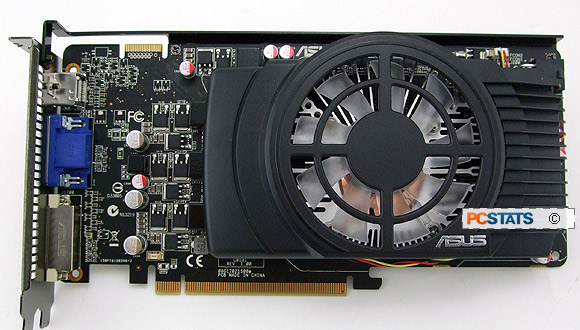
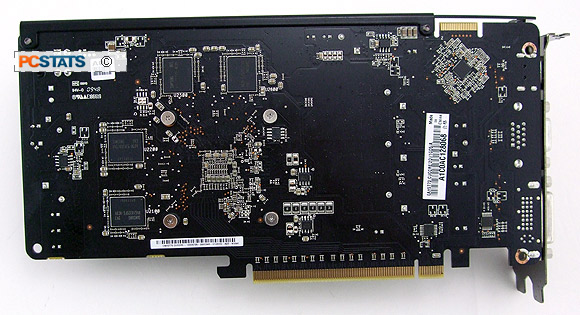
|
|
|
|
INCLUDES:
User's Manual, Driver CD, Utility CD, Alone in the
Dark, HDMI to DVI converter, molex
to PCI Express adapter, CrossfireX bridge. |
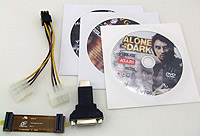 |
|
Graphics Processor: ATI
Radeon HD 5770 (850MHz)
Memory Capacity:
1GB GDDR5 (4800 MHz)
Card Format: PCI
Express x16 2.0, two slots wide.
Outputs:
HDMI, Analog, DVI-D
Videocard
Class:
Mainstream | |
| |
The ASUS EAH5770 CuCore/2DI/1GD5/A videocard retails for around $180 USD ($190 USD, £135 GBP), making the
nearest competitor the NVIDIA Geforce GTX 260 videocard or the Radeon HD
4870/4890 it is intended to replace. PCSTATS will be putting all
three of these videocards head to head on the test bench a little later in
this review. The ASUS EAH5770 CuCore/2DI/1GD5/A videocard is equipped
with HDMI, analog VGA and DVI video outputs, and can power up to two
displays at a time. The videocard comes with a HDMI to DVI converter, in case your monitor
doesn't accept HDMI input. The Asus EAH5770 CuCore can support resolutions of
up to 2560x1600 using its DVI connection, 2048 x 1536 using VGA or 1920
x 1200 using its HDMI 1.3 output, which also carries and audio signal.
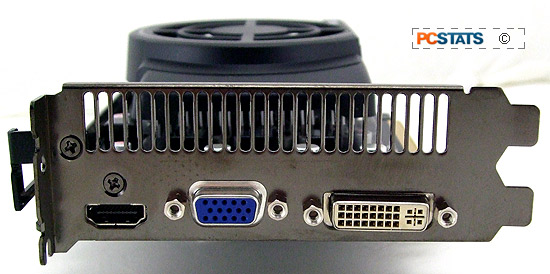
Like most Radeon 5000-series videocards, the Asus EAH5770 CuCore supports
onboard hardware HD decoding technologies. ATI's AVIVO HD video technology allows the GPU
to process video streams using the Universal Video Decoder. The Asus EAH5770 CuCore also supports
ATI Stream acceleration, with OpenCL and DirectCompute support for applications like video encoding.
The card requires one 6-pin PCI Express power connector, in addition to the
power it draws it from the PCI Express x16 slot its plugged into. Moving from
the Radeon 4000 series to the Radeon 5000 series has also seen a die-shrink from
55nm down to 40nm, so the Asus EAH5770 CuCore's TDP remains quite low, at just
108W. This is considerably lower than videocards based on NVIDIA's GT200 and
GT200b GPUs, which typically draw upwards of 150W. The EAH5770 CuCore also comes
with a molex-to-PCI Express power converter if you need it.
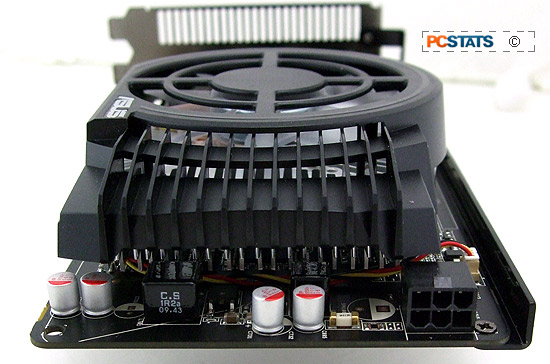
ASUS' EAH5770 CuCore/2DI/1GD5/A videocard can be paired up with another Radeon HD
5770 or 5750 videocard in CrossfireX mode, with both videocards sitting in a
compatible motherboard and connected together using a Crossfire bridge (included
with the EAH5770 CuCore).
Cooling for the Radeon HD 5770 GPU comes care of the
massive CuCore cooler - basically a larger copper block with an extruded
aluminum heatsink surrounding it. The heatsink is cooled by a modestly low noise
fan, which in tern is covered by a plastic grating. The design of the Asus
EAH5770 CuCore videocard's cooler doesn't push air out of the back your case, so
it's a good idea to have an internal fan set up to push air out of the back of
the case.
ATI Radeon RV840 Juniper GPU
ATI's Radeon 5770 graphics card is powered by the RV840 'Junpier' GPU, the
middle child of ATI's 'Evergreen' family of 5000-series Radeon videocards. As
the mid-range offering the 'Juniper' Radeon HD 5770 is between the mainstream
'Redwood' Radeon HD 5670 and the high-end 'Cypress' Radeon HD 5850 and 5870
videocards in terms of price, power and complexity.
All of AMD's Radeon 5000-series of graphics cards share a number of new
technologies, the most important of which is support for DirectX 11. This latest
revision to Microsoft's graphics hardware standard brings two major additions to
the DX11, tessellation and compute shaders. Tessellation is a method of adding
density and complexity to a 3D mesh. It can take a simple, low-poly model and
break up the geometry into more complex portions, adding another layer of detail
on top of a mesh. The end result is better looking, more detailed graphics with
a very low cost in performance.
Compute shaders allow DirectX 11-based GPUs to do tasks normally reserved for
CPUs. This will play a big role in desktop applications that harness the power
of a PCs videocard, as well as enable games programmers use the GPU to compute
things like physics and AI. Again, this opens up the possibility for more
immersive gaming, but with a miniscule performance penalty when compared to
using a CPU.
The ATI RV840 GPU in the ASUS EAH5770 CuCore/2DI/1GD5/A
videocard contains some 1.04 billion transistors manufactured on a 40nm process,
or about half of that used on the massive 2.15 billion transistor 'Cypress' GPU
(Radeon HD 5870). If you take a look at the chart below, you'll actually notice
quite a few similarities to last-generation's flagship, the Radeon HD 4870
videocard. Both videocards have around 1 billion transistors, 800 stream
processors, 40 texture units and 16 raster operators.
|
Midrange Videocard Comparison
Chart |
|
ATI Radeon 4870
|
ATI Radeon 4850
|
ATI Radeon HD
5770 |
ATI Radeon HD 5750
|
NVIDIA Geforce GTX
260 |
| GPU Code Name: |
RV770 |
RV770 |
RV840/Juniper |
RV830/Juniper |
GT200b |
| GPU Process: |
55nm |
55nm |
40nm |
40nm |
55nm |
| GPU Transistors: |
956 Million |
956 Million |
1.04 Billion |
1.04 Billion |
1.4 Billion |
| TDP: |
110W |
110W |
108W |
86W |
171W |
| GPU Core Clock Speed: |
750MHz |
625MHz |
850Mhz |
700MHz |
576MHz |
| Memory Speed: |
900MHz (3600MHz GDDR5) |
993MHz (1986MHz GDDR3) |
1.2GHz(4.8Ghz GDDR5) |
1.15GHz(4.6Ghz GDDR5) |
999MHz(1998 GDDR2) |
| Memory Capacity: |
512MB/1GB |
512MB/1GB |
1GB
|
512MB/1GB
|
512MB GDDR3 |
| Memory Bus Width: |
256-bit |
256-bit |
128-bit |
128-bit |
448-bit |
| Stream Processors: |
800 |
800 |
800 |
720 |
216 |
| Texture units: |
40 |
40 |
40 |
36 |
72 |
| Raster Operators: |
16 |
16 |
16 |
16 |
28 | | |
ATI uses GDDR5 with all of its Radeon HD 5000-series of
videocards, and in this case the 'Juniper' Radeon HD 5770 is equipped with 1GB of GDDR5
video memory with a base clock of 1.2GHz, which is then quad-pumped up to
4.8GHz. Thanks to the increase in memory speed the memory bus can be shrunk from
256-bits down to 128-bits as well. A little bit of GPU to memory bandwidth
is lost in the process so the ATI Radeon HD 5770 averages around 77GB/s bandwidth,
while the Radeon HD 4870 averages 115GB/s. Furthermore, thanks to a die-shrink to
40nm, ATI is also able to make the RV840 'Juniper' GPU draw a
little less power than the previous generation.
|

